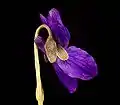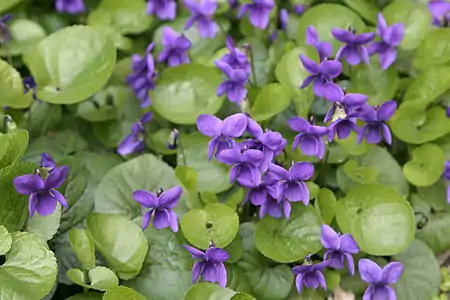| Viola odorata | |
|---|---|
 | |
| Scientific classification | |
| Kingdom: | Plantae |
| Clade: | Tracheophytes |
| Clade: | Angiosperms |
| Clade: | Eudicots |
| Clade: | Rosids |
| Order: | Malpighiales |
| Family: | Violaceae |
| Genus: | Viola |
| Species: | V. odorata |
| Binomial name | |
| Viola odorata | |
Viola odorata is a species of flowering plant in the family Violaceae, native to Europe and Asia. This small hardy herbaceous perennial is commonly known as wood violet,[1] sweet violet,[2] English violet,[2] common violet,[2] florist's violet,[2] or garden violet.[2] It has been introduced into the Americas and Australia.
Description
Viola odorata can be distinguished by the following characteristics:
- the flowers are scented[1]
- the flowers are normally either dark violet or white
- the leaves and flowers are all in a basal rosette
- the style is hooked (and does not end with a rounded appendage)
- the leaf-stalks have hairs which point downwards
- the plant spreads with stolons (above-ground shoots)
These perennial flowers mature at a height of 4–6 in (10–15 cm) and a spread of 8–24 in (20–61 cm).[1]
Distribution and habitat
V. odorata is native to Europe and Asia and has been introduced to the Americas and Australia.
The species can be found near the edges of forests or in clearings; it is also a common "uninvited guest" in shaded lawns or elsewhere in gardens.
Uses
Several cultivars have been selected for garden use, of which V. odorata 'Wellsiana' has gained the Royal Horticultural Society's Award of Garden Merit.[3][4]
The sweet scent of this flower has proved popular, particularly in the late Victorian period, and has consequently been used in the production of many cosmetic fragrances and perfumes.[5] The French are known for their violet syrup, most commonly made from an extract of violets. In the United States, this French violet syrup is used to make violet scones and marshmallows.
The scent of violet flowers is distinctive with only a few other flowers having a remotely similar odor. References to violets and the desirable nature of the fragrance go back to classical sources such as Pliny and Horace when the name "Ion" was in use to describe this flower from which the name of the distinctive chemical constituents of the flower, the ionones, is derived. In 1923, W.A. Poucher wrote that the flowers were widely cultivated both in Europe and the East for their fragrance, with both the flowers and leaves being separately collected and extracted for fragrance, and flowers also collected for use in confectionery galenical syrup[6] and in the production of medicine.
There is some doubt as to whether the true extract of the violet flower is still used commercially in perfumes.[7] It was still used in the early 20th century,[6] but by the time Steffen Arctander was writing in the late 1950s and early 1960s, production had "almost disappeared".[5] Violet leaf absolute, however, remains widely used in modern perfumery.[8][9]
The leaves are edible.[10] Real violet flower extract is available for culinary uses, especially in European countries.
Herbal medicine
As an ornamental and medicinal plant, Sweet Violet has been cultivated and used medicinally since the Middle Ages. V. odorata, along with others in the Violaceae family such as V. tricolor, has a long history of use in herbalism and folk medicine, particularly Iranian, Greco-Arab, Ayurvedic and Unani traditional health systems.[11] Phytochemical studies have shown that V. odorata contains the alkaloid violin, about 30 cyclotides, triterpenoids (mostly as constituents of the essential oil),[12] supporting long-held beliefs of its medicinal properties, that still have the need to be proven pharmacologycally.
In herbal medicine, V. odorata has been used for the treatment of whooping cough, headaches, migraine, insomnia, sore throat and epilepsy in children and adults, and clinical studies appear to confirm the safety and efficacy of V. odorata syrup in cough, insomnia and migraine treatments, and in treatment of pain, fever, cough, skin disorder, infection and inflammation.[13][14][15][16][17]
One specific study indicates that V. odorata extract given as a preventative/prophylactic is as effective as using corticosteroids reactively to treat specific types of lung disease.[17][18]
In mythology
The violet flower was a favorite in ancient Greece and became the symbol of Athens. The scent suggested sex, so the violet was an emblematic flower of Aphrodite and of her son, Priapus, the deity of gardens and generation.[19][20][21]
Iamus was a son of Apollo and the nymph Evadne. He was abandoned by his mother at birth. She left him lying in the Arkadian wilds on a bed of violets where he was fed honey by serpents. Eventually, he was discovered by passing shepherds who named him Iamus after the violet (ion) bed.
The goddess Persephone and her companion Nymphs were gathering rose, crocus, violet, iris, lily, and larkspur blooms in a springtime meadow when she was abducted by the god Hades.[22]
In culture
V. odorata may be the species mentioned in Shakespeare's famous lines:
- "I know a bank where the wild thyme blows,
- Where oxlips and the nodding violet grows,
- Quite over-canopied with luscious woodbine,
- With sweet musk-roses and with eglantine"[23]
Gallery

 form, with stolons visible
form, with stolons visible White V. odorata
White V. odorata
References
- 1 2 3 Asakawa, Bruce; Asakawa, Sharon (3 September 2001). California Gardener's Guide. Cool Springs Press. pp. 38–39. ISBN 978-1-930604-47-6. Retrieved 25 November 2011.
- 1 2 3 4 5 "Viola odorata". Germplasm Resources Information Network. Agricultural Research Service, United States Department of Agriculture. Retrieved 18 December 2017.
- ↑ "Viola odorata 'Wellsiana' (Vt)". Royal Horticural Society. Retrieved 1 March 2020.
- ↑ "AGM Plants - Ornamental" (PDF). Royal Horticultural Society. July 2017. p. 107. Retrieved 18 February 2019.
- 1 2 Perfume and Flavor Materials of Natural Origin by Steffen Arctander, First published 1961, ISBN 0-931710-36-7, ISBN 978-0-931710-36-0
- 1 2 Poucher, W.A. (1923). Perfumes Cosmetics and Soaps, Vol. 2, Chapter V: Monographs on Flower Perfumes.
- ↑ "Violet". fragrantica.
- ↑ Curtis & Williams (2009). An Introduction to Perfumery. 2nd Edition. ISBN 978-0-9608752-8-3. ISBN 978-1-870228-24-4.
- ↑ "Essential oils". Bo Jensen.
- ↑ "Edible Flowers Violets".
- ↑ Mahboubi, Mohaddese; Taghizadeh Kashani, Leila Mohammad (December 2018). "A Narrative study about the role of Viola odorata as traditional medicinal plant in management of respiratory problems". Advances in Integrative Medicine. 5 (3): 112–118. doi:10.1016/j.aimed.2017.12.003. S2CID 80368847.
- ↑ Mittal, Payal; Gupta, Vikas; Goswami, Manish; Thakur, Nishant; Bansal, Praveen (2015). "PHYTOCHEMICAL AND PHARMACOLOGICAL POTENTIAL OF VIOLA ODORATA". International Journal of Pharmaceutical Sciences and Research. 2 (6). doi:10.13040/ijpsr.0975-8232.ijp.2(5).215-20.
- ↑ Qasemzadeh, MJ; Sharifi, H; Hamedanian, M; Gharehbeglou, M; Heydari, M; Sardari, M; Akhlaghdoust, M; Minae, MB (Oct 2015). "The Effect of Viola odorata Flower Syrup on the Cough of Children With Asthma: A Double-Blind, Randomized Controlled Trial". J Evid Based Complementary Altern Med. 20 (4): 287–291. doi:10.1177/2156587215584862. PMID 25954025.
- ↑ Amer, A; Mehlhorn, H (2006). "Repellency effect of forty-one essential oils against Aedes, Anopheles, and Culex mosquitoes". Parasitol. Res. 99 (4): 478–90. doi:10.1007/s00436-006-0184-1. PMID 16642384. S2CID 206987619.
- ↑ "Sweet Violet". WebMD.
- ↑ PDR for Herbal Medicines. Thomson PDR. 2004. ISBN 9781563635120.
- 1 2 Mahboubi, Mohaddese; Taghizadeh Kashani, Leila Mohammad (2018-12-01). "A Narrative study about the role of Viola odorata as traditional medicinal plant in management of respiratory problems". Advances in Integrative Medicine. 5 (3): 112–118. doi:10.1016/j.aimed.2017.12.003. ISSN 2212-9588. S2CID 80368847.
- ↑ Koochek, M. H.; Pipelzadeh, M. H.; Mardani, H. (2003-07-17). "The Effectiveness of Viola odorata in the Prevention and Treatment of Formalin-Induced Lung Damage in the Rat". Journal of Herbs, Spices & Medicinal Plants. 10 (2): 95–103. doi:10.1300/J044v10n02_11. ISSN 1049-6475. S2CID 72377651.
- ↑ Hatfield, Audrey Wynne (1973). A Herb for Every Ill. St. Martin's Press. p. 173.
- ↑ Roberts, Margaret (2000). Edible & Medicinal Flowers. New Africa Books. p. 79.
- ↑ Cumo, Christopher (2013). Encyclopedia of Cultivated Plants. ABC-CLIO. p. 1113. ISBN 9781598847758.
- ↑ "Plants and flowers of Greek myth". Theoi Project.
- ↑ Shakespeare, William. A midsummer night's dream.
External links
- "Viola odorata L." Australian Plant Name Index (APNI), IBIS database. Centre for Plant Biodiversity Research, Australian Government.
- The American Violet Society
